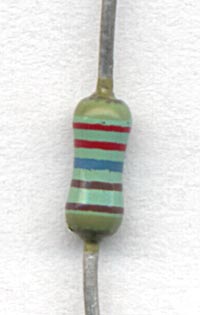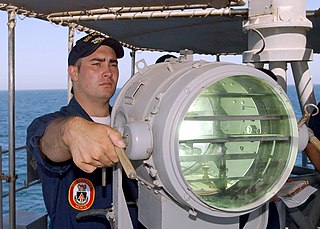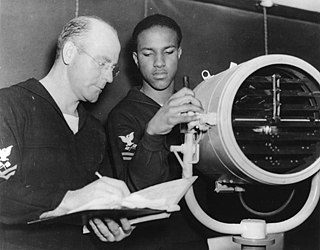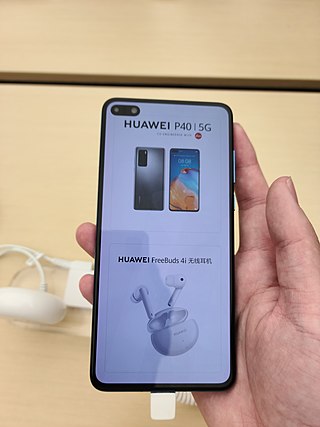Related Research Articles

Black is a color that results from the absence or complete absorption of visible light. It is an achromatic color, without hue, like white and grey. It is often used symbolically or figuratively to represent darkness. Black and white have often been used to describe opposites such as good and evil, the Dark Ages versus Age of Enlightenment, and night versus day. Since the Middle Ages, black has been the symbolic color of solemnity and authority, and for this reason it is still commonly worn by judges and magistrates.

A color code is a system for encoding and representing non-color information with colors to facilitate communication. This information tends to be categorical though may also be sequential.

Telegraphy is the long-distance transmission of messages where the sender uses symbolic codes, known to the recipient, rather than a physical exchange of an object bearing the message. Thus flag semaphore is a method of telegraphy, whereas pigeon post is not. Ancient signalling systems, although sometimes quite extensive and sophisticated as in China, were generally not capable of transmitting arbitrary text messages. Possible messages were fixed and predetermined, so such systems are thus not true telegraphs.

An electronic color code or electronic colour code is used to indicate the values or ratings of electronic components, usually for resistors, but also for capacitors, inductors, diodes and others. A separate code, the 25-pair color code, is used to identify wires in some telecommunications cables. Different codes are used for wire leads on devices such as transformers or in building wiring.

Optical communication, also known as optical telecommunication, is communication at a distance using light to carry information. It can be performed visually or by using electronic devices. The earliest basic forms of optical communication date back several millennia, while the earliest electrical device created to do so was the photophone, invented in 1880.
In computing, on the X Window System, X11 color names are represented in a simple text file, which maps certain strings to RGB color values. It was traditionally shipped with every X11 installation, hence the name, and is usually located in <X11root>/lib/X11/rgb.txt. The web colors list is descended from it but differs for certain color names.

A registered jack (RJ) is a standardized telecommunication network interface for connecting voice and data equipment to a computer service provided by a local exchange carrier or long distance carrier. Registered interfaces were first defined in the Universal Service Ordering Code (USOC) system of the Bell System in the United States for complying with the registration program for customer-supplied telephone equipment mandated by the Federal Communications Commission (FCC) in the 1970s. They were subsequently codified in title 47 of the Code of Federal Regulations Part 68. Registered jack connections began to see use after their invention in 1973 by Bell Labs. The specification includes physical construction, wiring, and signal semantics. Accordingly, registered jacks are primarily named by the letters RJ, followed by two digits that express the type. Additional letter suffixes indicate minor variations. For example, RJ11, RJ14, and RJ25 are the most commonly used interfaces for telephone connections for one-, two-, and three-line service, respectively. Although these standards are legal definitions in the United States, some interfaces are used worldwide.

Complementary colors are pairs of colors which, when combined or mixed, cancel each other out by producing a grayscale color like white or black. When placed next to each other, they create the strongest contrast for those two colors. Complementary colors may also be called "opposite colors".

International maritime signal flags are various flags used to communicate with ships. The principal system of flags and associated codes is the International Code of Signals. Various navies have flag systems with additional flags and codes, and other flags are used in special uses, or have historical significance.

Olive is a dark yellowish-green color, like that of unripe or green olives.
Flag signals can mean any of various methods of using flags or pennants to send signals. Flags may have individual significance as signals, or two or more flags may be manipulated so that their relative positions convey symbols. Flag signals allowed communication at a distance before the invention of radio and are still used especially in connection with ships.

A signal lamp is a visual signaling device for optical communication by flashes of a lamp, typically using Morse code. The idea of flashing dots and dashes from a lantern was first put into practice by Captain Philip Howard Colomb, of the Royal Navy, in 1867. Colomb's design used limelight for illumination, and his original code was not the same as Morse code. During World War I, German signalers used optical Morse transmitters called Blinkgerät, with a range of up to 8 km (5 miles) at night, using red filters for undetected communications.
The following are common definitions related to the machine vision field.

The Apollo program used several television cameras in its space missions in the late 1960s and 1970s; some of these Apollo TV cameras were also used on the later Skylab and Apollo–Soyuz Test Project missions. These cameras varied in design, with image quality improving significantly with each successive model. Two companies made these various camera systems: RCA and Westinghouse. Originally, these slow-scan television (SSTV) cameras, running at 10 frames per second (fps), produced only black-and-white pictures and first flew on the Apollo 7 mission in October 1968. A color camera – using a field-sequential color system – flew on the Apollo 10 mission in May 1969, and every mission after that. The color camera ran at the North American standard 30 fps. The cameras all used image pickup tubes that were initially fragile, as one was irreparably damaged during the live broadcast of the Apollo 12 mission's first moonwalk. Starting with the Apollo 15 mission, a more robust, damage-resistant camera was used on the lunar surface. All of these cameras required signal processing back on Earth to make the frame rate and color encoding compatible with analog broadcast television standards.

Flag semaphore is a semaphore system conveying information at a distance by means of visual signals with hand-held flags, rods, disks, paddles, or occasionally bare or gloved hands. Information is encoded by the position of the flags; it is read when the flag is in a fixed position. Semaphores were adopted and widely used in the maritime world in the 19th century. It is still used during underway replenishment at sea and is acceptable for emergency communication in daylight or using lighted wands instead of flags, at night.
Variations of gray or grey include achromatic grayscale shades, which lie exactly between white and black, and nearby colors with low colorfulness. A selection of a number of these various colors is shown below.
In Nepal, all road vehicles with or without a motor are tagged with a registration number. This is issued by the state-level Transport Management Office, a government agency under the Department of Transport Management. The license plates must be placed in the front as well as back of the vehicle. The international vehicle registration code for Nepal is NEP.

Semaphore is the use of an apparatus to create a visual signal transmitted over distance. A semaphore can be performed with devices including: fire, lights, flags, sunlight, and moving arms. Semaphores can be used for telegraphy when arranged in visually connected networks, or for traffic signalling such as in railway systems, or traffic lights in cities.

Wigwag is an historical form of flag signaling that passes messages by waving a single flag. It differs from flag semaphore in that it uses one flag rather than two, and the symbols for each letter are represented by the motion of the flag rather than its position. The larger flag and its motion allow messages to be read over greater distances than semaphore. Messages could be sent at night using torches instead of flags.

Huawei P40 is a line of high-end Android-based smartphones manufactured by Huawei. Unveiled on 26 March 2020, they succeed the Huawei P30 in the company's P series line.
References
- Christopher H. Sterling, Military communications: from ancient times to the 21st century, p. 27, 2008 ISBN 9781851097326
- Andrew White, Military Signal Corp Manual, 1918